GIGABYTE Z97X-UD5H Review: Choose Your Storage Option
by Ian Cutress on May 14, 2014 9:00 AM EST- Posted in
- Motherboards
- Intel
- Gigabyte
- Z97
Real World CPU Benchmarks
Readers of our motherboard review section will have noted the trend in modern motherboards to implement a form of MultiCore Enhancement / Acceleration / Turbo (read our report here) on their motherboards. This does several things – better benchmark results at stock settings (not entirely needed if overclocking is an end-user goal), at the expense of heat and temperature, but also gives in essence an automatic overclock which may be against what the user wants. Our testing methodology is ‘out-of-the-box’, with the latest public BIOS installed and XMP enabled, and thus subject to the whims of this feature. It is ultimately up to the motherboard manufacturer to take this risk – and manufacturers taking risks in the setup is something they do on every product (think C-state settings, USB priority, DPC Latency / monitoring priority, memory subtimings at JEDEC). Processor speed change is part of that risk which is clearly visible, and ultimately if no overclocking is planned, some motherboards will affect how fast that shiny new processor goes and can be an important factor in the purchase.
Rendering – Adobe After Effects CS6: link
Published by Adobe, After Effects is a digital motion graphics, visual effects and compositing software package used in the post-production process of filmmaking and television production. For our benchmark we downloaded a common scene in use on the AE forums for benchmarks and placed it under our own circumstances for a repeatable benchmark. We generate 152 frames of the scene and present the time to do so based purely on CPU calculations.
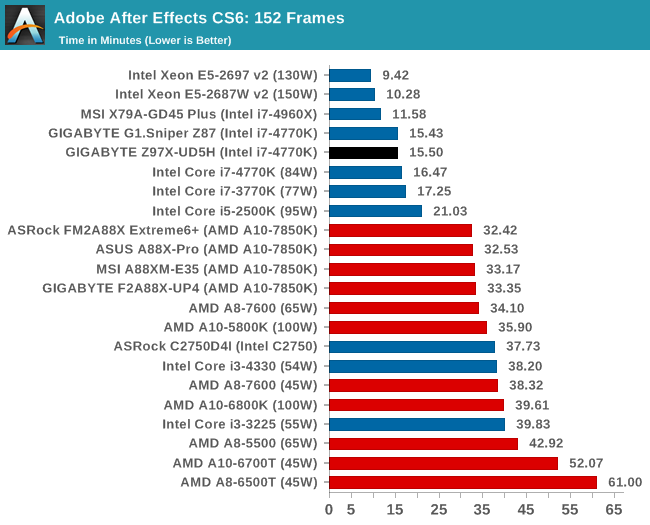
Compression – WinRAR 5.0.1: link
Our WinRAR test from 2013 is updated to the latest version of WinRAR at the start of 2014. We compress a set of 2867 files across 320 folders totaling 1.52 GB in size – 95% of these files are small typical website files, and the rest (90% of the size) are small 30 second 720p videos.
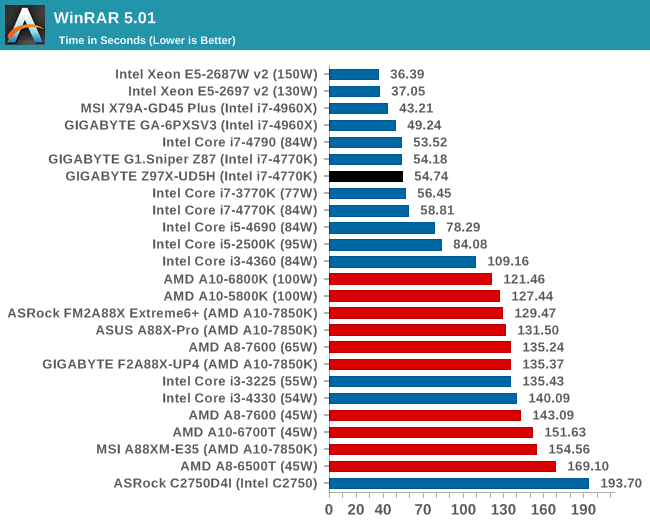
Image Manipulation – FastStone Image Viewer 4.9: link
Similarly to WinRAR, the FastStone test us updated for 2014 to the latest version. FastStone is the program I use to perform quick or bulk actions on images, such as resizing, adjusting for color and cropping. In our test we take a series of 170 images in various sizes and formats and convert them all into 640x480 .gif files, maintaining the aspect ratio. FastStone does not use multithreading for this test, and thus single threaded performance is often the winner.
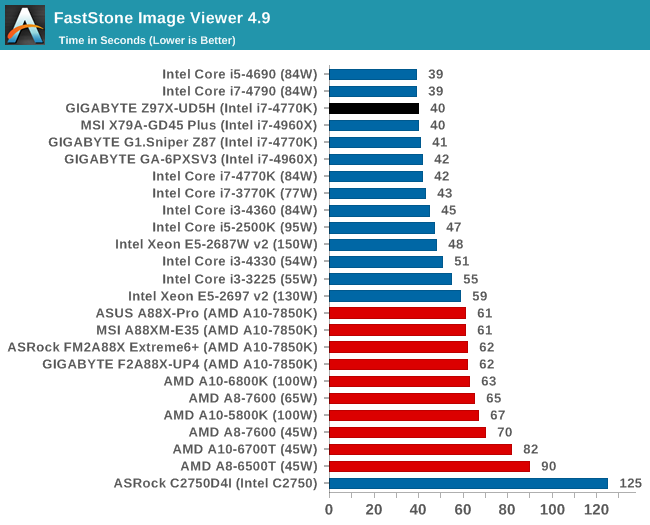
Video Conversion – Xilisoft Video Converter 7: link
The XVC test I normally do is updated to the full version of the software, and this time a different test as well. Here we take two different videos: a double UHD (3840x4320) clip of 10 minutes and a 640x266 DVD rip of a 2h20 film and convert both to iPod suitable formats. The reasoning here is simple – when frames are small enough to fit into memory, the algorithm has more chance to apply work between threads and process the video quicker. Results shown are in seconds and time taken to encode.
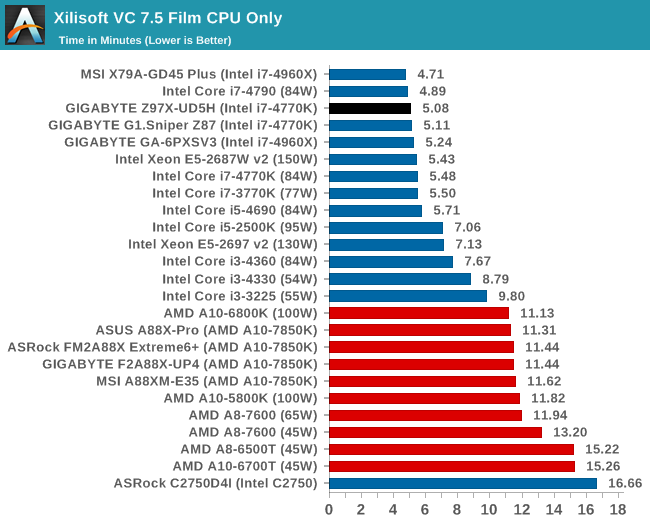
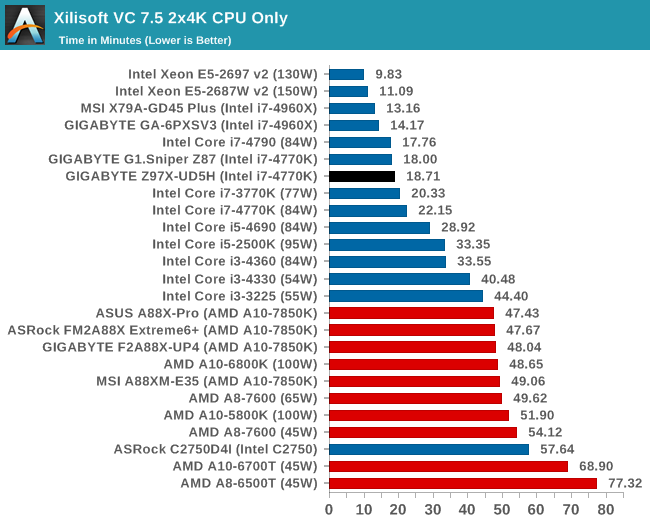
Video Conversion – Handbrake v0.9.9: link
Handbrake is a media conversion tool that was initially designed to help DVD ISOs and Video CDs into more common video formats. The principle today is still the same, primarily as an output for H.264 + AAC/MP3 audio within an MKV container. In our test we use the same videos as in the Xilisoft test, and results are given in frames per second.
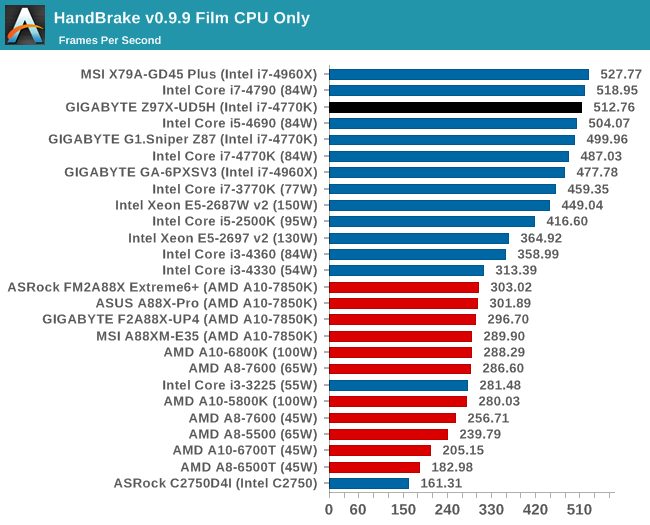
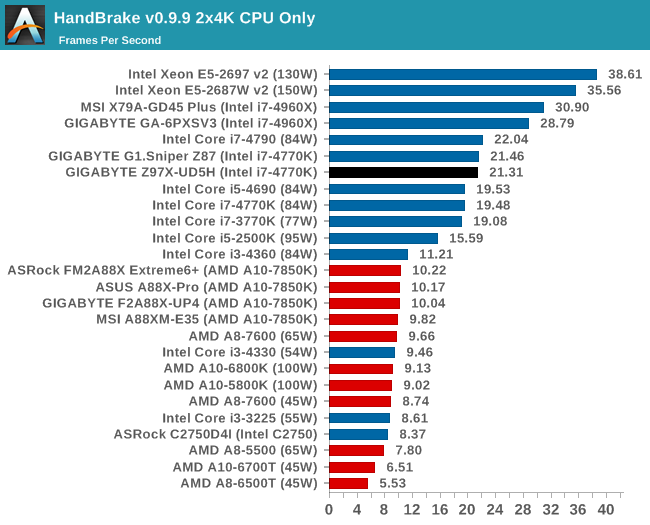
Rendering – PovRay 3.7: link
The Persistence of Vision RayTracer, or PovRay, is a freeware package for as the name suggests, ray tracing. It is a pure renderer, rather than modeling software, but the latest beta version contains a handy benchmark for stressing all processing threads on a platform. We have been using this test in motherboard reviews to test memory stability at various CPU speeds to good effect – if it passes the test, the IMC in the CPU is stable for a given CPU speed. As a CPU test, it runs for approximately 2-3 minutes on high end platforms.
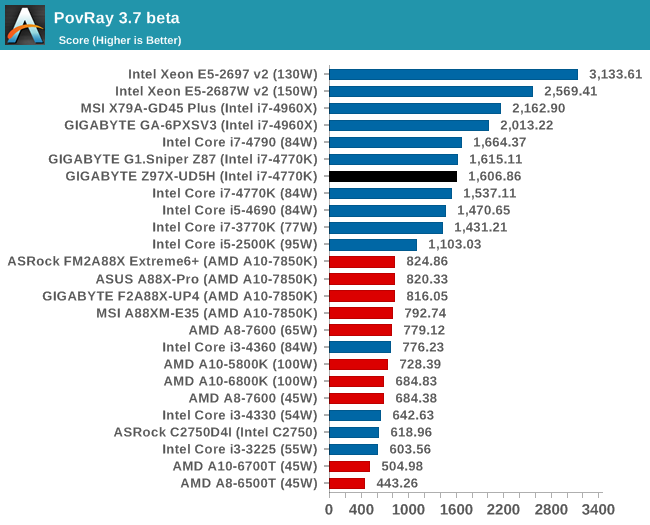










53 Comments
View All Comments
silenceisgolden - Wednesday, May 14, 2014 - link
So I think I might be a few PCIe lanes off, but would it be feasible to get rid of the PCI, one LAN slot, the D-SUB (because why is that still useful with DVI available), the PCI Express/M.2/SATA6 switch but keep the M.2? Then either add in another USB3, SATA6, or if possible in the future, another M.2 stacked on top of the first. I would think this would be the best combination of connectivity that the mainstream to enthusiast range of PC builders are looking for, and would stop the continuation of older standards or these choices that people have to make that might not be obvious when they are plugging stuff in to the motherboard.Chil - Wednesday, May 14, 2014 - link
The BIOS screenshots of both HD and Classic Mode show a BCLK of 99.79 MHz. Isn't the standard 100.0? Can anyone comment on if this is a bug or expected behavior and how it affects performance?The_Assimilator - Wednesday, May 14, 2014 - link
It's possible that AnandTech had Spread Spectrum enabled, but I have that option disabled on my Asrock Z77 Extreme6, and its BCLK fluctuates between 99.97MHz and 99.99MHz at boot (I have never seen it do a flat 100.00MHz).Chil - Thursday, May 15, 2014 - link
99.97 is right around what I expect, but 99.79 (0.21 off the mark) is a different story. I did a big of searching and this appears to affect Gigabyte's entire "ultra durable" lineup.maecenas - Wednesday, May 14, 2014 - link
Given that you've run a few articles explaining how modern games are GPU dependent, and very rarely is the CPU the bottleneck in single-card applications, I'm really not clear on how a motherboard is going to have a significant impact on gaming performance, holding the GPU and CPU constant.extide - Wednesday, May 14, 2014 - link
It doesnt. The only thing is really the PCIe lane allocation, and if it possibly uses a PLX chip. Also, the feature set may be different, but the motherboard doesn't really affect performance.Ian Cutress - Wednesday, May 14, 2014 - link
PCIe lane allocation is important if you are not limited by the CPU first (see our Haswell refresh). There are some weird and wonderful chipset lane allocations when you move into the world of the PLX chip, or some server boards miss out lanes altogether. If/when I move to 4K gaming benchmarks (2015? depends on 24"/27" 60Hz monitor pricing) we might see a greater effect there.The_Assimilator - Wednesday, May 14, 2014 - link
Flex IO is a step in the right direction from Intel. That said, it could be so much more; in fact it would make the most sense if ALL Flex IO ports were switchable between PCIe/USB3/SATA3. That would allow motherboard manufacturers to provide e.g. native 10 SATA ports without having to purchase and integrate additional standalone SATA controllers, which are slower and add to the BOM. I'd be pretty happy with a motherboard that did a 2/8/8 split for PCIe/USB3/SATA3.Additionally, the 14 USB 2.0 ports are ridiculous; I don't think I've ever seen a motherboard that provides that many. Intel should aggregate 10 of those ports into an additional Flex IO port, which would leave 4 USB 2.0 ports. Anyone who needs more than a minimum of 8 USB ports (4 USB2 + minimum of 4 USB3) can buy a USB hub.
DanNeely - Wednesday, May 14, 2014 - link
8 back panel ports and 3 mobo headers for 6 more was a relatively common config a few years ago. I think I've seen 6 back panel and 4 headers a few times too. 3 mobo headers covers a case with 4 front panel ports and a card reader in a drive bay. Other than being mostly USB3 this board has the same 8 back panel and 3 header configuration.I'm not sure why Intel didn't cut the number of 2.0 ports down when they added USB3 to the chipset, but IIRC a USB2 controller is tiny compared to a USB3/PCIe lane/Sata6 controller. It's entirely possible that it came down to the 2.0 controllers being a small enough chunk of the chip that it wasn't worth fiddling with them because it couldn't affect enough space to matter for anything else.
repoman27 - Wednesday, May 14, 2014 - link
Well A: the USB 2.0 controllers, hubs, ports were already there, so it's easier to just let them be, and B: every USB 3.0 port uses a USB 2.0 port as well. Thus you really have a maximum of 14 USB ports total, up to 6 of which can be USB 3.0.